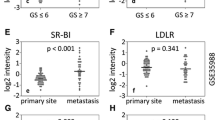Summary
Sex Hormone Binding Globulin (SHBG), in addition to regulating free concentrations of steroid sex hormones in plasma, also participates in membrane-based steroid signaling in breast and prostate cells. In this study, we address whether the breast and prostate can synthesize their own SHBG. SHBG mRNA and protein were detected in human breast and prostate cancer cell lines, as well as in normal and cancerous breast and prostate tissue where it was prominent in epithelial cells. In cultured human LNCaP prostate cancer cells, SHBG was found both in the cytoplasm, and on the outer cell membrane where it was presumably bound to its high affinity receptor (RSHBG). When LNCaP cells were treated with 2-methoxyestradiol (2MeOE2), an antagonist of SHBG binding to RSHBG, membrane-associated SHBG was eliminated. These results demonstrate that the breast and prostate can synthesize SHBG locally, and that SHBG can bind to, and perhaps participate in autocrine and/or paracrine signaling through RSHBG. Therefore, perturbations in SHBG expression in breast and prostate tumors may affect the regulation of steroid signaling through RSHBG and target SHBG-mediated biologic properties at the cellular level.
Access this chapter
Tax calculation will be finalised at checkout
Purchases are for personal use only
Preview
Unable to display preview. Download preview PDF.
Similar content being viewed by others
References
Bérubé D, Séralini G, Gagné R, et al (1990) Localization of the human SHBG gene to the short arm of chromosome 17. Cytogenet Cell Genet 54:65–67.
April, 2003 UCSC Human Genome Project Working Draft-http://genome.ucsc.edu/cgi-bin/hgTracks?positionX16351&hgsid=22396239
Khan MS, Knowles BB, Aden D, Rosner W (1981) Secretion of testosterone-estradiol-binding globulin by a human hepatoma-derived cell line. J Clin Endocrinol Metab 53:448–449.
Rosner W, Christy NP, Kelly WG (1966) Evidence for the presence of an estrogen-binding β-globulin in plasma. J Clin End Metab 26:1399–1403.
Rosner W, Smith RN (1975) Isolation and characterization of the testosterone-estradiol-binding globulin from human plasma. Use of a novel affinity column. Biochemistry 14:4813–4820.
Lipworth L, Adami HO, Trichopoulos D, et al (1996) Serum steroid hormone levels, SHBG, and body mass index in the etiology of postmenopausal breast cancer. Epidemiology 7:96–100.
Endogenous Hormones and Breast Cancer Collaborative Group (2002) Endogenous sex hormones and breast cancer in postmenopausal women: reanalysis of nine prospective studies. J Natl Cancer Inst 94:606–616.
Gann PH, Hennekens CH, Ma J, et al (1996) Prospective study of sex hormone levels and risk of prostate cancer. J Natl Cancer Inst 88:1118–26.
Garland CF, Friedlander NJ, Barrett-Conner E, et al (1992) Sex hormones and postmenopausal breast cancer: a prospective study in an adult community. Am J Epidemiol 135:1220–1230.
Helzlsouer KJ, Alberg AJ, Bush TL, et al (1994) A prospective study of endogenous hormones and breast cancer. Cancer Detect Prev 18:79–85.
Eaton NE, Reeves GK, Appleby PN, et al (1999) Endogenous sex hormones and prostate cancer. Br J Cancer 80:930–934.
Heikkila R, Aho K, Heliovaara M, et al (1999) Serum testosterone and SHBG concentrations and the risk of prostate carcinoma. Cancer 86:312–315.
Hryb DJ, Khan MS, Romas NA, et al (1990) The control of the interaction of SHBG with its receptor by steroid hormones. J Biol Chem 265:6048–6054.
Kahn S, Hryb DJ, Nakhla AM, et al (2002) SHBG is synthesized in target cells. J Endocrinol 175:113–120.
Fissore F, Fortunati N, Comba A, et al (1994) The receptor-mediated action of sex steroid binding protein (SBP, SHBG): accumulation of cAMP in MCF-7 cells under SBP and estradiol treatment. Steroids 59:661–667.
Nakhla AM, Khan MS, Rosner W (1990) Biologically active steroids activate receptor-bound human SHBG to cause LNCaP cells to accumulate adenosine 3′,5′-monophosphate. J Clin Endo Metab 71:398–404.
Nakhla A, Rosner W (1996) Stimulation of prostate cancer growth by androgens & estrogens through intermediacy of SHBG. Endocrinology 137:4126–4129.
Fortunati N, Fissore F, Fazzari A, et al (1996) Sex steroid binding protein exerts a negative control on estradiol action in MCF-7 cells through cyclic adenosine 3′,5′-monophosphate and PKA. Endocrinology 137:686–692.
Hryb DJ, Khan MS, Rosner W (1985) Testosterone-estradiol-binding globulin binds to human prostatic cell membranes. BBRC 128:432–440.
Hryb DJ, Khan MS, Romas NA, et al (1990) The control of the interaction of SHBG with its receptor by steroid hormones. J Biol Chem 265:6048–6054.
Frairia R, Fortunati N, Berta L, et al (1991) Sex steroid binding protein (SBP) receptors in estrogen sensitive tissues. J Ster Biochem Mol Biol 40:805–812.
Porto CS, Musto NA, Bardin CW, et al (1992) Binding of an extracellular steroid-binding globulin to membranes and soluble receptors from human breast cancer cells (MCF-7 cells). Endocrinology 130:2931–2936.
Nakhla AM, Leonard J, Hryb DJ, et al (1999) Sex hormone-binding globulin receptor signal transduction proceeds via a G protein. Steroids 64:213–216.
Nakhla A, Romas N, Rosner W (1997) Estradiol activates the prostate AR and PSA secretion through intermediacy of SHBG. J Biol Chem 272:6838–6841.
Hryb DJ, Nakhla AM, Kahn, S, et al (2002) SHBG in the human prostate is locally synthesized and may act as an autocrine/paracrine effector. J Biol Chem 277:26618–26622.
Author information
Authors and Affiliations
Editor information
Editors and Affiliations
Rights and permissions
Copyright information
© 2005 Springer Science+Business Media, Inc.
About this chapter
Cite this chapter
Kahn, S.M., Hryb, D.J., Nakhla, A.M., Khan, S.M., Romas, N.A., Rosner, W. (2005). Immunohistochemical and In-Situ Detection of Sex Hormone-binding Globulin (SHBG) Expression in Breast and Prostate Cancer: Implications for Hormone Regulation. In: Li, J.J., Li, S.A., Llombart-Bosch, A. (eds) Hormonal Carcinogenesis IV. Springer, Boston, MA. https://doi.org/10.1007/0-387-23761-5_56
Download citation
DOI: https://doi.org/10.1007/0-387-23761-5_56
Publisher Name: Springer, Boston, MA
Print ISBN: 978-0-387-23783-1
Online ISBN: 978-0-387-23761-9
eBook Packages: MedicineMedicine (R0)




